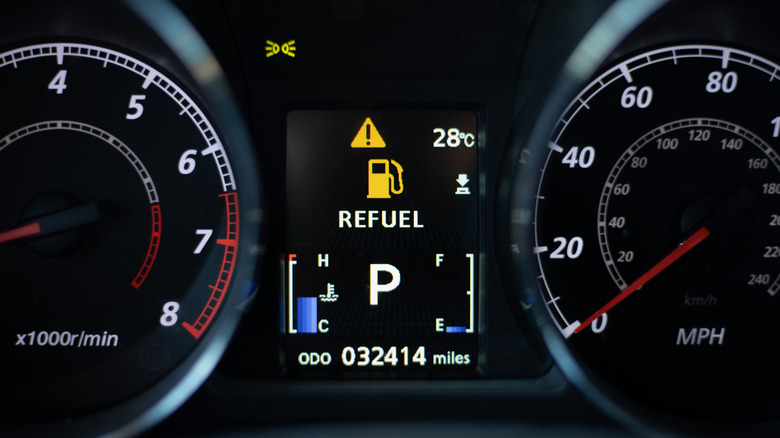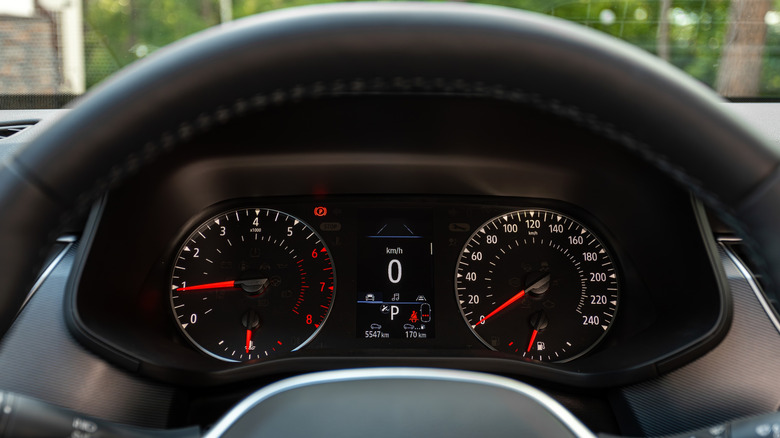Think Your Digital Odometer Has Been Tampered With? Here's What To Look For
There's a common misconception that digital odometers have helped solve the deceptive practices of odometer fraud. But the reality is far more concerning. Sure, digital odometers have opened new avenues for precise mileage readings and fuel efficiency tracking. But at the same time, they have opened a minefield of car scams that buyers face when buying a used vehicle. Fraudsters have now traded electric drills (which are used to alter mileage readings in manual odometers) for cheap and accessible reprogramming devices that rob countless people of their hard-earned money.
According to the NHTSA, odometer fraud is a silent epidemic that happens on nearly half a million vehicles annually in the U.S. While it's illegal, greedy criminals still use this technique to roll back mileage readings, and the result is a market flooded with vehicles boasting lower mileage than they truly are. But why should you care? Mileage readings are not just numbers on a screen; they're one of the most accurate indicators of a car's history. So, when a seller tampers with the mileage reading, you'll overpay for a car that's far more worn than advertised. Even worse, you'll inherit problems that will leave you with costly repair bills.
Now, at first glance, these digital manipulations might be challenging to detect. But (luckily), they always leave clues that should make you think twice about your potential purchase. With that in mind, here is a guide that will walk you through the red flags that will tell you a lot about your odometer.
Signs that a seller has tampered with the digital odometer
Gone are the days when you would pop the hood to spot odometer tampering by examining the physical gears. With digital odometers on the rise, it's now challenging to detect if a seller has manipulated the mileage readings. Nonetheless, there are simple clues you can look out for.
First, you'll want to check for inconsistent wear and tear. After all, a vehicle's interior tells its real story and the pedals, steering wheel, gear knob, and seat bolsters should be your key area of interest. For instance, if the rubber covering the pedals is polished smoothly, that's a major red flag, since they should have a moderate texture at low miles. Additionally, if the interior has sagging seats or the lettering on the gear knob has faded, it is possible that the car has a lot of miles on it, which means the mileage readings should be a bit higher.
Once you've inspected the interior, go ahead and play detective and ask for the vehicle's service records. Even better, get a CarFax report. This document offers detailed information about a car's past that the seller might not disclose. These include title history, previous owners, and service records — which usually show progress in mileage that should be steady. So, if the numbers suddenly rewind or seem irregular (like a car shedding 30,000 miles between oil changes), that's manipulation, and it's one of the red flags you can't ignore on a CarFax report.
Other Red Flags to look out for and preventative measures
Beyond the physical signs, there are certain technical and behavioral indicators that can help determine if you're falling victim to digital odometer fraud. If you decide to go through a personal seller to buy a car, the seller's behavior should be among the first things to check to know whether or not it's a legitimate deal.
For instance, if requests for service records or a vehicle history report are met with hesitation, deflection, or vague promises, that should be a warning red flag. Similarly, if the purchase sounds too good to be true (like unbelievably low prices), think twice before buying the car. While everyone loves a bargain, prices that undercut the market, especially for low-mileage models, are often bait.
You can also avoid this scam by contacting the manufacturer to get the car's real history. Using the 17-digit VIN, you can request a vehicle history report (even from an authorized dealership) to verify if the last recorded mileage during service aligns with the seller's claim. Of course, this crosscheck will definitely take a few minutes, but it will save you from a six-figure mistake.
Lastly, always follow these mechanic-approved tips when buying a used car. You should always insist on seeing the vehicle in person. This way, you will carefully inspect the car for signs of rust, a worn-out steering wheel, and damaged seats (all proof of a higher mileage vehicle).


